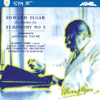Elgar Symphony No 3 - Sketches & Commentary
View record and artist detailsRecord and Artist Details
Composer or Director: Edward Elgar
Label: NMC
Magazine Review Date: 3/1998
Media Format: CD or Download
Media Runtime: 70
Mastering:
DDD
Catalogue Number: NMCD052

Tracks:
| Composition | Artist Credit |
|---|---|
| Symphony No. 3 |
Edward Elgar, Composer
Andrew Davis, Conductor BBC Symphony Orchestra David Owen Norris, Piano Edward Elgar, Composer Robert Gibbs, Violin |
Composer or Director: Edward Elgar
Genre:
Orchestral
Label: NMC
Magazine Review Date: 3/1998
Media Format: CD or Download
Media Runtime: 56
Mastering:
DDD
Catalogue Number: NMCD053

Tracks:
| Composition | Artist Credit |
|---|---|
| Symphony No. 3 |
Edward Elgar, Composer
Andrew Davis, Conductor BBC Symphony Orchestra Edward Elgar, Composer |
Author: Andrew Achenbach
And what thoughts they are! The sweeping, almost grimly defiant opening paragraph with its gaunt parallel open fifths (the first 17 bars of which Elgar actually left in full score) is hard to dislodge from one’s mind, as is the sublimely wistful second subject. After an unexpected exposition repeat (Elgar’s, not Payne’s, in case you were wondering), the development is launched with a magical new idea, whose incense-laden mystery and wonderfully penetrating harmonic scope seem to cast a wistful glance back to the world of the oratorios. From a series of seemingly unpromising fragments, Payne proceeds to fashion a movement of great power and immensely satisfying proportions, while his stunningly idiomatic orchestration, deft and opulent by turns, will surely win him many plaudits.
Next to the mighty edifice of that Allegro molto maestoso, the succeeding Allegretto is more in the nature of a woodland interlude or divertissement. The winsome main idea is drawn from Elgar’s 1923 incidental score for Laurence Binyon’s drama, Arthur. There are also two contrasting episodes, the second of which features a delectable little tune in A major. I was reminded here of Elgar’s happy phrase, when he likened the Trio of the First Symphony to “something you hear down by the river”.
By contrast, the Adagio solenne slow movement wears a nobly tragic, world-weary demeanour. The mournful, daringly harmonized introduction immediately grips with its pain and anguish, yet the achingly rapt D major second subject seems to offer new hope. Between these two themes comes another one of those visionary ideas (from 3'29'') which, as Payne asserts (rightly in my view), “positively demands the sound of muted strings”. (One thinks of those two almost unbearably intimate string paragraphs in the Second Symphony’s Larghetto.) The close could hardly be more chilling, a single solo viola note hanging in the air; it was this phrase, marked fine, that the dying composer gave to his dear friend, the violinist W. H. Reed, uttering the famous words: “Billy, this is the end.”
The finale begins with a rousing fanfare (in Elgar’s scoring) and struts out in confident, bustling fashion (“heroic, almost chivalric”, is how Payne describes it). All the same, the thematic invention is not quite on the same level as in the remainder (much of it is again drawn from the Arthur music), though the second subject has a Cockaigne-like swagger about it. Payne’s resolution is intriguing, ingenious and, naturally, very personal. I still don’t find it terribly satisfying, but everyone will form their own view – and anyway, there is so much in the preceding 55 minutes for which to be exceedingly thankful.
All praise to Andrew Davis and the BBC SO for such an eloquent, profoundly involving performance and to the production team for obtaining such handsome, indeed demonstration-worthy sound (can this sumptuous acoustic really be Maida Vale Studio No. 1?). The companion issue is also beautifully realized, with over 50 musical examples, including the sketches for violin and piano that Elgar would play through on the piano with Billy Reed. There are excellent contributions here from David Owen Norris and Robert Gibbs (the latter uses Reed’s own instrument). A fascinating and, above all, deeply rewarding pair of CDs which no Elgarian will want to miss.'
Discover the world's largest classical music catalogue with Presto Music.

Gramophone Digital Club
- Digital Edition
- Digital Archive
- Reviews Database
- Full website access
From £8.75 / month
Subscribe
Gramophone Full Club
- Print Edition
- Digital Edition
- Digital Archive
- Reviews Database
- Full website access
From £11.00 / month
Subscribe
If you are a library, university or other organisation that would be interested in an institutional subscription to Gramophone please click here for further information.





